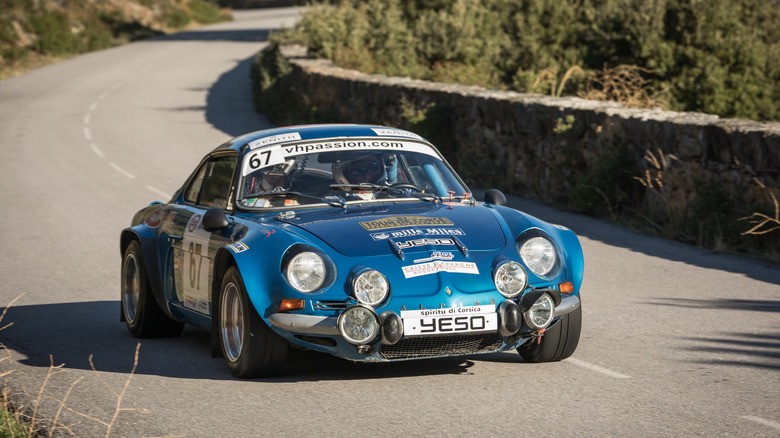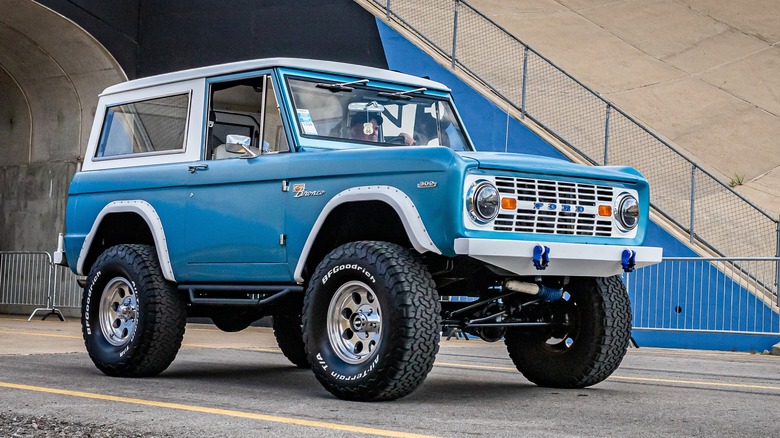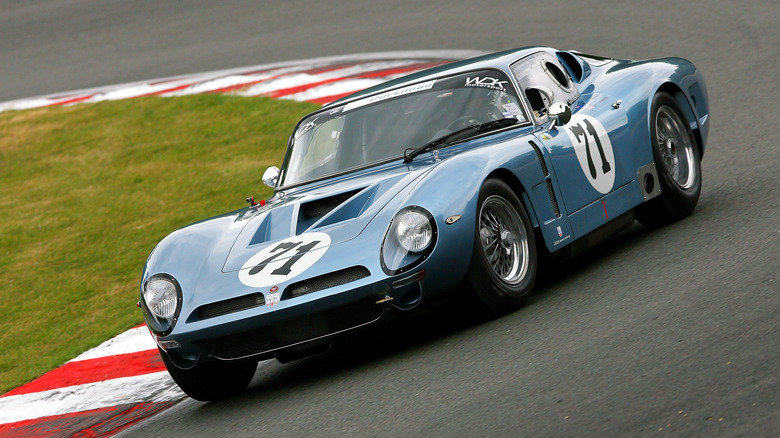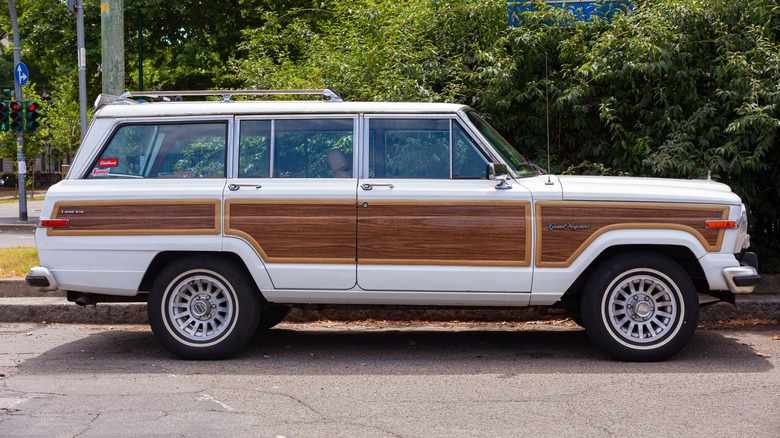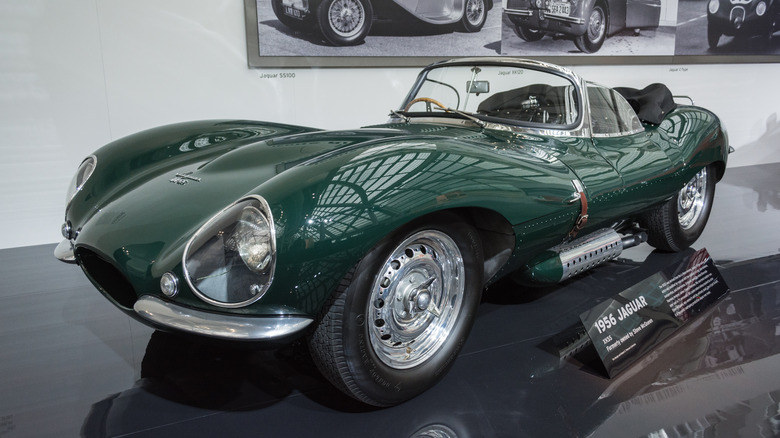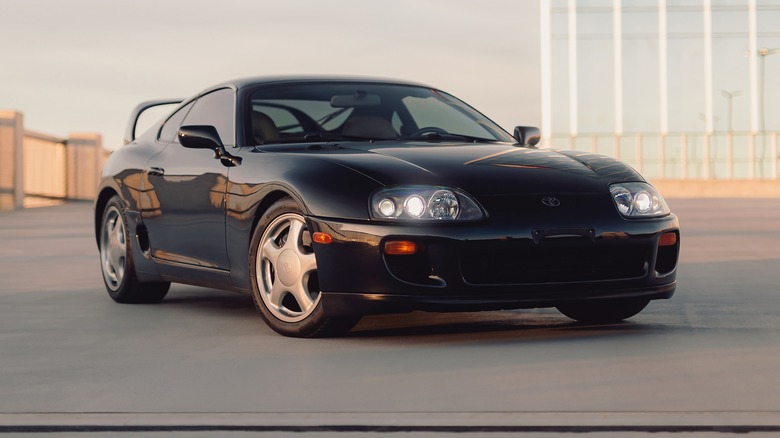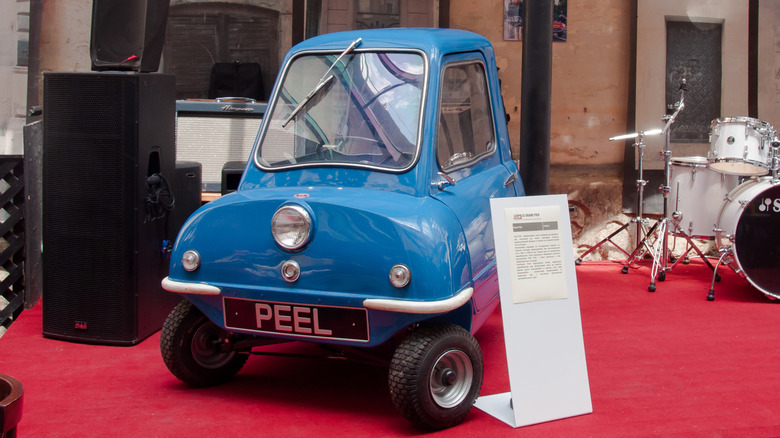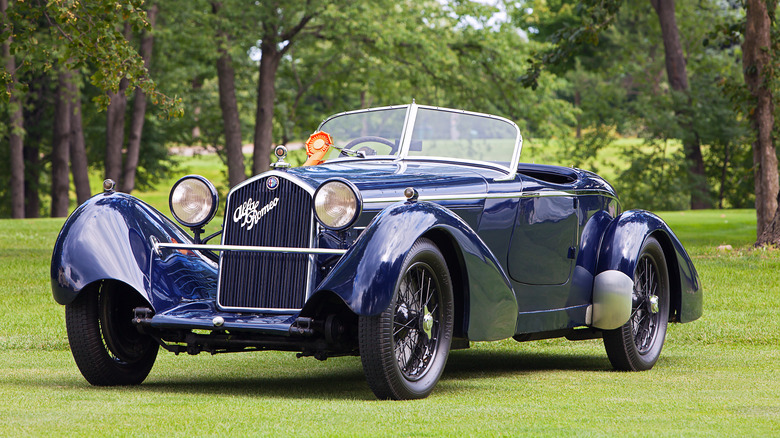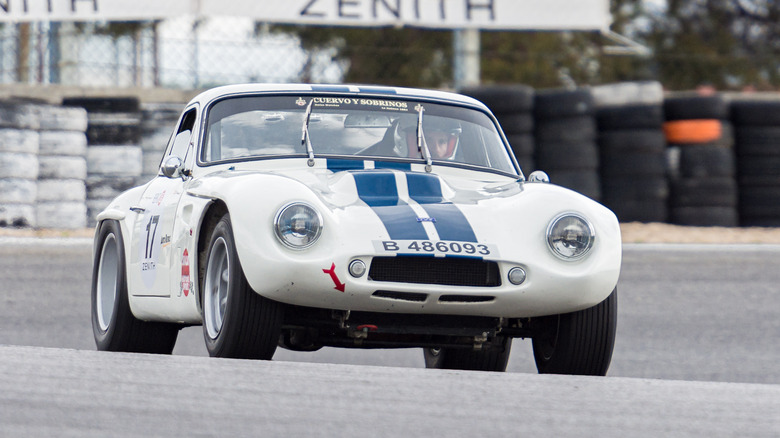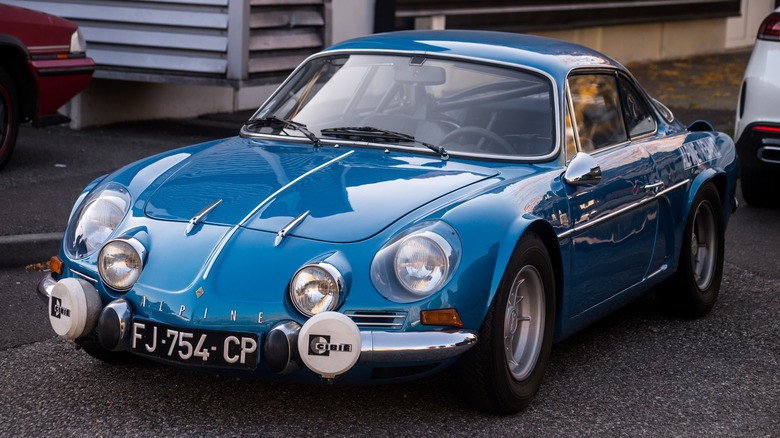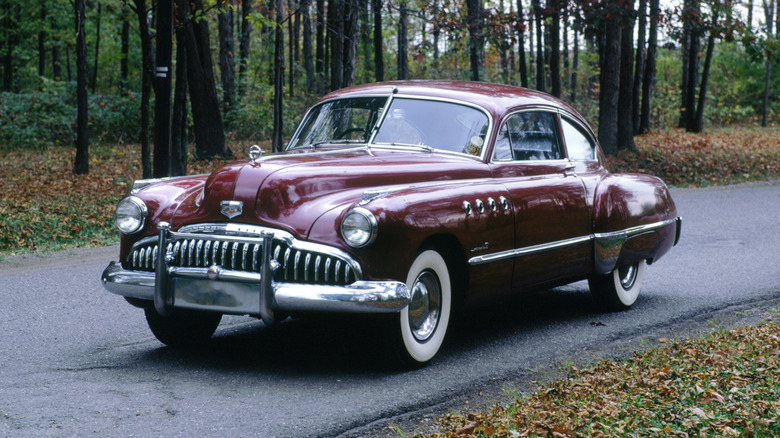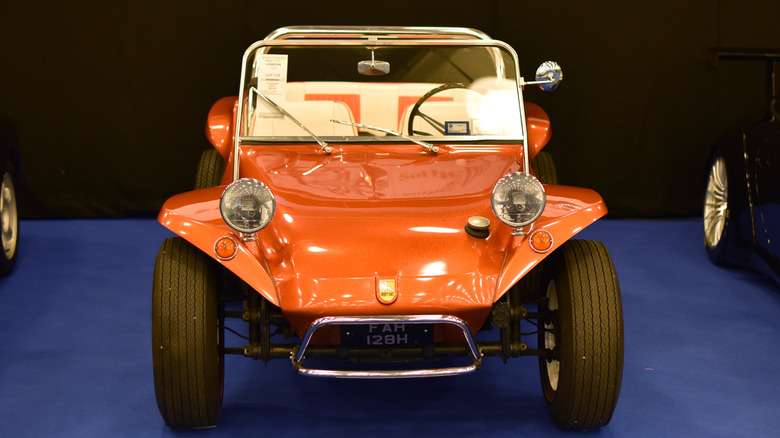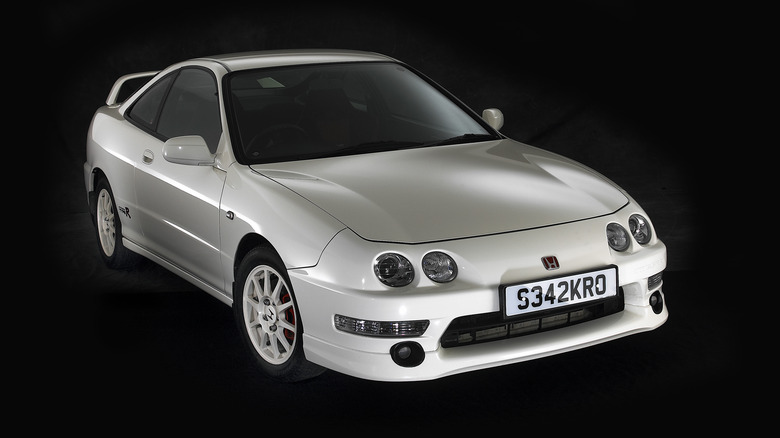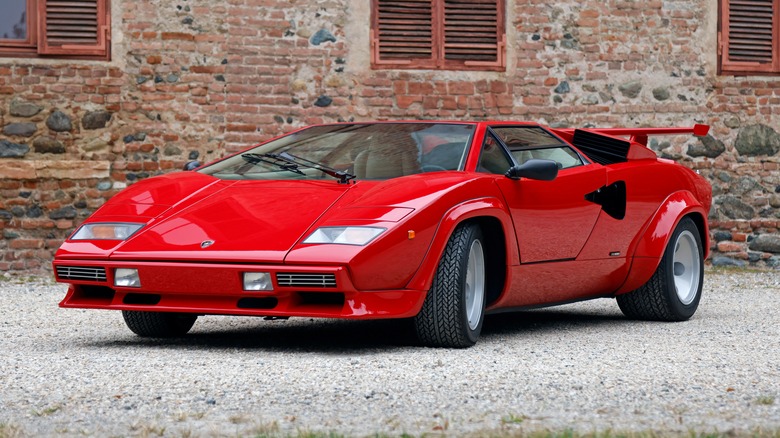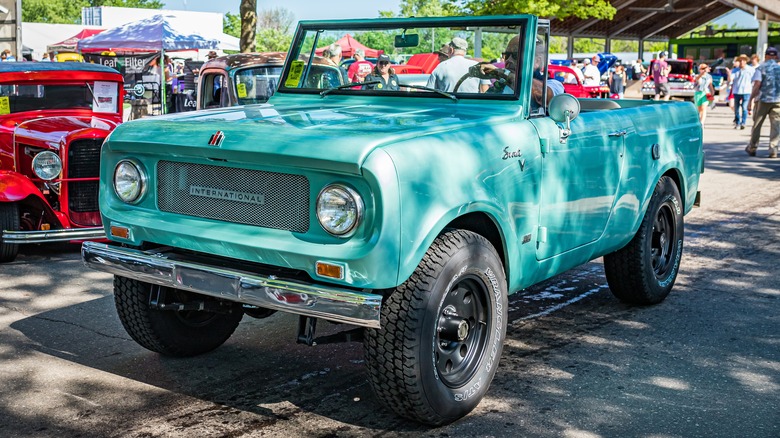Classic Cars That Got Resurrected Years Later
Recent years have seen a slew of classic car nameplates consigned to the history books. Long-running models like the VW Beetle and Chevy Impala ended production after decades in dealerships, killed off by the seemingly unstoppable rise of the crossover SUV. However, it's not all bad news: For every nameplate that's been retired, another has been brought back to life, in most cases being reinvented for the modern market while drawing as much design inspiration as possible from its predecessor.
While plenty of these revivals have proven to be surefire hits among buyers, not every classic car resurrection has been so successful. In a handful of cases, manufacturers have even been accused of resurrecting a name mostly as a cash grab, and doing a disservice to the legacy of the original car in the process. The classic car resurrection trend has caught on in every segment of the market, from obscure low-volume sports cars to iconic SUVs. With the recent announcement that VW Group is bringing back one of America's best-loved classic trucks in the near future, it seems that trend is set to continue for years to come.
Ford Bronco
First launched in 1965, the Ford Bronco's original three-decade-long production run saw it become a household name. Ultimately, changing consumer tastes saw the Bronco axed in 1996. It was replaced by the four-door Expedition, which has remained a strong seller for Ford up to today. It never managed to garner quite the same fanbase though, and enthusiasts instead continued to wish for the return of Ford's original SUV.
That wish was granted when the revived Bronco entered the market for the 2021 model year, proving itself to be an instant sales hit. Ford managed to strike just the right balance between heritage and contemporary, equipping the Bronco range with all the modern conveniences buyers wanted without compromising on the truck's go-anywhere capabilities or retro styling. Unfortunately for Bronco fans, production bottlenecks due to pandemic restrictions and the ongoing chip shortage have meant that demand for new models far outstrips supply. However, as we noted in our full Bronco review, it's this scarcity that's really the only downside to the new generation of this car.
Bizzarrini 5300 GT Strada
While the name might not be familiar to anyone who doesn't possess an encyclopedic knowledge of obscure Italian sports cars, Bizzarrini was one of the most important marques of the '60s. Its eponymous founder Giotto Bizzarrini started his automotive career at Alfa Romeo, before moving on to Ferrari. There, he designed the iconic 250 GTO and 250 SWB, but was unceremoniously sacked by Enzo Ferrari after a disagreement in 1961. From there, Bizzarrini worked freelance for a few years, designing the original Lamborghini V12 engine that would continue to power the brand's cars right up until the Murcielago.
By 1964, Bizzarrini had decided to form his own car brand, and produced several low-volume models, with the most successful being the 5300 GT Strada. It won its class at the 1965 24 Hours of Le Mans, but unfortunately, few buyers were interested in the road-going version. The business eventually declared bankruptcy in 1969, and despite a few attempted revivals over the following decades, remained largely dormant until 2018. The rights to the name were bought out by a new group of investors, and a limited run of 24 new 5300 GT Strada cars was created from the original '60s blueprint. After the success of this classic revival, Bizzarrini is now developing an all-new hypercar called the Giotto, but details remain scant for now.
Jeep Grand Wagoneer
In the early '80s, Jeep decided to take its already-aging Wagoneer and add in a suite of luxury features not seen in any other SUV on sale in America at the time. The Grand Wagoneer was born, debuting in 1984 and proving to be very popular among well-heeled buyers. Its ancient underpinnings were ultimately the reason it was axed in 1991, as it couldn't meet updated safety standards and its economy was terrible even for a truck of its size. Even through its later years, it still remained popular, and there were plenty of people that were sad to see it go.
With the market for huge luxury trucks booming once again, Jeep re-introduced the Grand Wagoneer in 2022. We drove it and found it to be as lavish as you'd expect, with a smooth V8 powerplant and more hauling capability than many other luxury-oriented SUVs. It's not the most sleek or refined option on the market, and much like its predecessor, it's very thirsty. Then again, few buyers cared about those flaws in the original Grand Wagoneer, and it's likely that even fewer buyers of the new generation SUV will do.
Jaguar XKSS
The XKSS was the road-going version of the legendary Jaguar D-Type race car, which made history by winning the 24 Hours of Le Mans three consecutive times between 1955 and 1957. A total of 25 examples of the XKSS were planned, but only 16 made it out of the factory. The remaining nine ended up being destroyed in a factory fire in 1957, but in 2016, Jaguar announced it would restart production of the classic model to complete the original production run.
Each one was hand-built at the firm's facility in Warwick, England, with virtually no deviation from the original plans. The only minor alterations were made in the name of safety — for example, the fuel tank was constructed with non-original materials to allow the car to run on modern fuel. Other than that, these resurrected XKSSs were exactly the same as the cars that left the factory in the '50s. Each car sold for around $1.5 million, but a few examples have changed hands since for several hundred thousand more than the original asking price.
Toyota Supra
It seems like every JDM fan has a strong opinion on the new Supra. Some are thrilled by its very existence, hailing it as a return to form for a manufacturer that, for years, seemed reluctant to make cars that anyone would actually enjoy driving. Equally, there are some that think it's a total failure, criticizing its close relationship to the BMW Z4 and subsequent reliance on BMW's parts bin. Love it or hate it, there's no denying that the return of the Supra was a major milestone for Toyota. The MkIV Supra has ascended to near-mythical status among a certain type of enthusiast, and with the MkV, Toyota finally gives fans the follow-up they've been waiting two decades for.
Even with its part-German heritage, we were impressed with the GR Supra 3.0 when we spent some time with it in 2022. It blends practicality with performance in a way that few other cars in its price bracket do, and if you can put aside its divisive looks and Z4-derived interior, it's a great car to drive. Whether that's enough to make it a future classic is debatable, but then, living up to the legacy of the MkIV was always going to be an impossible task.
Peel P50
Perhaps one of the oddest classic car resurrections, the Peel P50 holds the Guinness World Record for the world's smallest production car. It has done so since production began in 1962, although its initial production run was a short one, only lasting until 1965. The company itself went bankrupt a few years later in 1970. The P50 languished in obscurity for decades after, until it was brought back into the spotlight in 2008 by Jeremy Clarkson, who drove one around the BBC offices in a viral segment of "Top Gear." A couple of years later, two entrepreneurs bought the rights to the brand and went on "Dragon's Den," the British equivalent of "Shark Tank," asking for an £80,000 investment to help restart production of the Peel.
They landed the investment and production began shortly after. At the time of writing, two variants of the P50 are available to order, one electric and one gas-powered. The tiny cars are road legal not only in Britain and Europe, but also in the U.S., with at least one new Peel confirmed to have made it Stateside.
Alfa Romeo 8C
While it might not have been the fastest nor the best-handling supercar of its generation, there's no doubting the modern Alfa Romeo 8C's ability to command attention. Be that passersby ogling its one-of-a-kind design or drivers admiring its thunderous V8 soundtrack, the 8C stands out as one of the defining Italian supercars of the '00s, alongside other greats like the Ferrari Enzo and Maserati MC12.
While the modern 8C's design was created from the ground up, its name was borrowed from a line of equally attention-grabbing vintage Alfa Romeo race cars. The 8C moniker was historically used by Alfa on a range of straight eight racing machinery throughout the '30s, with 8C cars winning at Mille Miglia and four times at the most famous race of them all, Le Mans. The modern 8C was never developed into a competition car, but rather as a highly sought-after collectors' special. A 500-unit run was produced, with all 500 examples selling out before production had even begun.
TVR Griffith
The TVR Griffith holds the distinction of being resurrected not once but twice, with the original classic race car of the '60s being the first to bear the name. The moniker was brought back for a second generation in 1990, launching at the Birmingham Motor Show to great success. TVR claims that one car was sold every eight minutes of the show, and that initial buyer enthusiasm showed no signs of slowing down. Production of the Griffith would continue until 2002, when it would be replaced by the Tuscan (which, incidentally, was also a resurrected nameplate from earlier in the brand's history).
After TVR went bankrupt in 2006, a long period of inactivity followed before a third generation of the Griffith was unveiled in prototype form in 2017. The car was initially planned to enter production the year after, but delays around funding and complications surrounding TVR's new factory have meant that the release window has been pushed back to 2024 at the earliest. Still, TVR's chairman has insisted that the new car is still very much in development, with prototypes currently being assembled to send off to third-party suppliers for testing.
Alpine A110
The original Alpine A110 was both a commercially successful road car and a decorated race car, with an especially impressive track record in rallying. It became one of the most revered rally icons of its era, but A110 variants also competed in everything from Le Mans to hill climbs. It was axed in 1971 in favor of an all-new car, the A310, but the impending oil crisis meant that the latter never sold well. Renault eventually bought a majority stake in Alpine and absorbed it into its own lineup, where it saw mixed fortunes before declining sales saw it axed altogether in 1995.
By the early 2010s, Renault had decided that the time was right to relaunch Alpine as a standalone brand. The reborn A110 was entirely new underneath, but its design made clear references to the original '60s classic. More recently, a range-topping A110S was launched with 288 horsepower, although sadly, there is still no plan to bring the car to the U.S. for now. That's a huge shame, especially since the new A110 is one of the best handling cars on the market — so good, in fact, that McLaren F1 designer Gordon Murray even used it as the benchmark for his new T.50 hypercar.
Buick Roadmaster
The Buick Roadmaster name has its roots in pre-WWII motoring, but it's best known as a '40s and '50s land yacht that's highly coveted among collectors today. When the Roadmaster was axed in 1958, it had evolved into a range-topping celebration of excess, with big fins and chrome everywhere. The revived B-body Roadmaster of 1991 was a much more underwhelming affair, being built on an aging platform that had barely changed since its introduction in 1977.
To call it tried-and-tested would be putting it nicely, with the Roadmaster's old-school V8 engine and body-on-frame construction failing to excite anyone apart from retirees and sensible middle-class families at the time. Ironically, that ancient construction has made the car a niche enthusiasts' favorite today, since its easily-wrenchable internals are far closer to the classics of the '60s than anything else of its era. They're also cheap to buy, and since all the important parts had been in production for decades by the time the revived Roadmaster arrived, they've proven themselves to be very reliable over the years too.
Meyers Manx
While it wasn't the first beach buggy, the Meyers Manx was the first car that made beach buggies cool. Built on the bones of the VW Beetle, the Manx took Ferdinand Porsche's ubiquitous design and added a custom fiberglass body shell, go-anywhere capability, and a fashionable surf chic look. Over 5,000 examples of the Manx were sold during its original run, but the company's demise came about as a result of a controversial legal judgment concerning copycat buggy builders. Despite having patents for all the key aspects of his design, a judge ruled that founder Bruce Meyers' buggy was not unique enough to classify as protected under patent law.
This essentially opened the door for any kit maker to clone the Manx without legal repercussions, and Meyers was eventually forced to close his company in 1971 after too many copycat startups emerged. After nearly 30 years away from the industry, Meyers relaunched his company as Meyers Manx Inc. in 2000, selling a range of updated versions of the Manx buggy. The relaunch was commercially successful, and today the company even offers an electric version of the buggy called the Manx 2.0.
Acura Integra
The DC2 Acura Integra Type-R is the stuff of legend, with a reputation among enthusiasts as one of the best-handling FWD cars ever made. The previous-generation Integra (known as the RSX in North America) was discontinued in 2006, with enthusiasts longing for its return ever since. That meant the rebooted 2023 Integra had some seriously big shoes to fill, but our first drive of the car confirmed that it could live up to the hype. Since then, Acura has also unveiled a more powerful Type S variant, which boasts 320 horsepower and 318 pound-feet of torque.
Honda wisely chose to stick with a familiar formula for the latest generation of the car, with all models being FWD and a manual transmission available. It worked, as the order books quickly began to fill up, and buyers faced a waiting list that was several months long at launch. Fingers crossed that the Integra's sales success continues well into 2023 and beyond, as affordable, stick-shift sports sedans are a dying breed, but one that there's clearly still plenty of demand for if they're as good as this.
Lamborghini Countach
One of the most controversial nameplate relaunches of recent times was that of the Lamborghini Countach, a supercar icon that was originally produced from 1974 to 1990. It became one of the most instantly recognizable supercars thanks to its unique wedge-shaped design and groundbreaking performance, and its success influenced many other cars of the era. With its naturally-aspirated V12 engine, outlandish looks, and complete disregard for everyday practicality, the Countach set the template for what a supercar should be.
Despite becoming the poster child for performance cars of its time, the Countach never actually sold that well, and by 1990 it had been replaced by the Diablo. In 2021, Lamborghini announced it was relaunching the nameplate for a second generation, with a strictly-limited 112 units on offer. Rather than being a radical new design like the original Countach, the new car was essentially a rebodied Sian, which itself was heavily based on the Aventador. It shared a powertrain with the Sian and claimed only marginally improved performance figures — plus, it cost $2.64 million. Marcello Gandini, the designer of the original Countach, issued an extraordinary press statement shortly after the launch, rebuking the car as a "repeat [of] a model of the past," and claiming he was not informed, nor did he approve of, the creation of a second-generation car. Lamborghini later played down his claims, but the implied accusation of the new Countach being a nostalgia-fueled cash grab has continued to spark debate among enthusiasts.
International Harvester Scout
Originally produced between 1961 and 1980, the Scout carved out a formidable reputation as one of the toughest 4x4s of its era. Over half a million examples were sold during its original production run, and in recent years, they've become a popular choice for overlanders and restomodders looking for a unique alternative to the usual classic Jeep or Land Cruiser. The Scout was originally produced by farm machinery manufacturer International Harvester, but the rights to the name are now under the ownership of VW Group.
VW recently announced it would relaunch Scout as an electric 4x4 brand, with all new trucks to be designed and built in the United States. The current plan is for the first Scout vehicles to hit the road in 2026, although few details are available on the specifics of the lineup so far. VW is reportedly building a dedicated new battery-electric platform for the Scout range rather than relying on one of its current platforms, so the resulting truck might well look very different from anything we've seen from the German carmaker so far. Pickup and SUV sales have remained among the most lucrative segments of the American auto market for years, so if VW can get the Scout relaunch right, it could well become a major player in the space in the near future.
